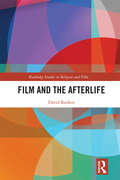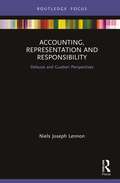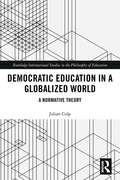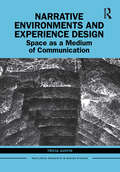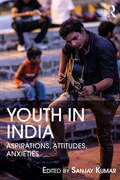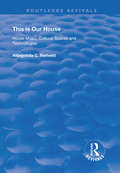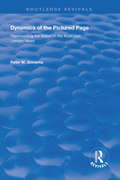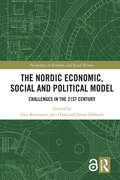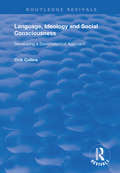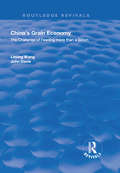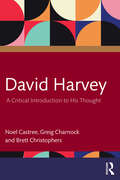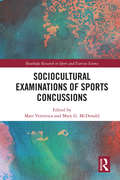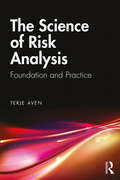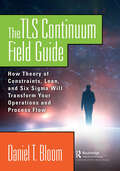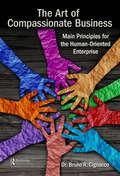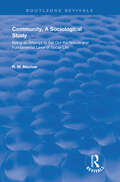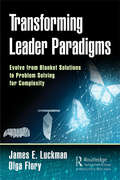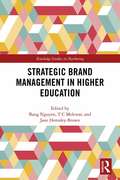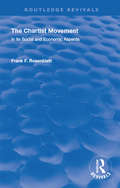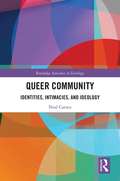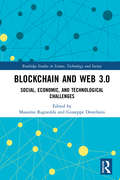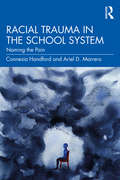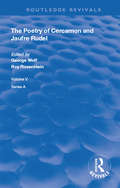- Table View
- List View
Film and the Afterlife (Routledge Studies in Religion and Film)
by David RankinThis book explores how post-death existence is represented in popular film, looking at issues such as continuity, personal identity, and the nature of existence beyond the grave. Film often returns to the theme of dying, death and the afterlife, both directly and indirectly, because there are very few subjects as compelling and universal. The book compares the representation of death, dying and the afterlife in films to scholarly surveys of attitudes towards life-after-death through the analysis of twenty films made between the end of World War II and now. It looks at the portrayals of stages between death and a final destination; spatio-temporal and personal continuity; the nature of afterlife existence in terms of embodiment, or not; and the contact between the worlds of the living and the dead. This book offers a wide-ranging view on a compelling subject in film. As such, it will be of great interest to scholars of Religion and Film, Religion and Media, the Philosophy of Religion, and the Sociology of Religion, as well as Religion, Media and Film Studies more generally .
Understanding Human Ecology: Knowledge, Ethics and Politics
by Geetha Devi T. V.This book examines the domain of human agency–environment interaction from a multidimensional point of view. It explores the human–environment interface by analysing its ethical, political and epistemic aspects – the value aspects that humans attribute to their environment, the relations of power in which the actions and their consequences are implicated and the meaning of human actions in relation to the environment. The volume delineates the character of this domain and works out a theoretical framework for the field of human ecology. This book will be a must-read for students, scholars and researchers of environmental studies, human ecology, development studies, environmental history, literature, politics and sociology. It will also be useful to practitioners, government bodies, environmentalists, policy makers and NGOs.
Accounting, Representation and Responsibility: Deleuze and Guattarí Perspectives (Routledge Focus on Accounting and Auditing)
by Niels Joseph LennonIn organizations, accounting produces organizational knowledge that affects decision-making and managerial action. Companies placing importance on shareholder value sometimes tend to elevate accounting to a higher truth criterion for justifying managerial actions. Yet, the nature of accounting renders it difficult to argue that accounting information necessarily produce a better basis for decision-making than arguments which are not based on accounting. This is because, as previous research has also argued, accounting counts some things but omits many others, while managers are accountable for much more than what accounting actually counts. Using a theoretical apparatus from Deleuze and Guattarí, this book illustrates that accounting-based actions such as making management decisions, maintaining organisational responsibility and hierarchical control are manifestations of the ways in which accounting is composed. This concise introduction will be invaluable for researchers and advanced students of management accounting exploring responsibility accounting and accountability.
Democratic Education in a Globalized World: A Normative Theory (Routledge International Studies in the Philosophy of Education)
by Julian CulpDue to the economic and social effects of globalization democracy is currently in crisis in many states around the world. This book suggests that solving this crisis requires rethinking democratic education. It argues that educational public policy must cultivate democratic relationships not only within but also across and between states, and that such policy must empower citizens to exercise democratic control in domestic as well as in inter- and transnational politics. Democratic Education in a Globalized World articulates and defends democratic conceptions of global citizenship education and educational justice on the basis of a democratic understanding of global justice. It will be of interest to researchers across the fields of education, political theory, philosophy, development and postcolonial studies.
Narrative Environments and Experience Design: Space as a Medium of Communication (Routledge Research in Design Studies)
by Tricia AustinThis book argues narrative, people and place are inseparable and pursues the consequences of this insight through the design of narrative environments. This is a new and distinct area of practice that weaves together and extends narrative theory, spatial theory and design theory. Examples of narrative spaces, such as exhibitions, brand experiences, urban design and socially engaged participatory interventions in the public realm, are explored to show how space acts as a medium of communication through a synthesis of materials, structures and technologies, and how particular social behaviours are reproduced or critiqued through spatial narratives. This book will be of interest to scholars in design studies, urban studies, architecture, new materialism and design practitioners in the creative industries.
Youth in India: Aspirations, Attitudes, Anxieties
by Sanjay KumarThis book explores the attitudes, anxieties and aspirations of India’s burgeoning young population in a globalised world. Drawing upon time-series survey data of the Indian youth aged between 15 and 34 years across 19 Indian states, it provides key insights into a range of themes along with an overview of the changing trends and patterns of their behaviour. The volume examines the job preferences of the Indian youth, their career priorities and opinions on reservations in employment and education sectors. It measures their degree of political participation and studies their attitude regarding political issues. It looks at aspects relating to their social and cultural contexts, preferences and practices, including lifestyle choices, consumption habits and social customs such as marriage, as they negotiate between tradition and modernity. Further, it discusses the anxieties and insecurities that the youth face, their mental health and their experiences of social discrimination. The essays here offer an understanding of a critical demographic and shed light on the challenges and opportunities that the Indian youth confront today. Lucid, accessible and empirically grounded, this volume will be useful to scholars and researchers of sociology, political sociology, political studies, youth psychology and anthropology as well as policymakers, journalists and the interested general reader.
This is Our House: House Music, Cultural Spaces and Technologies (Routledge Revivals)
by Hillegonda C. RietveldOriginally published in 1998. House music has had a considerable influence in shaping the sound of pop music from the late 1980s onwards. From underground dance events to the pop charts, traces of this aesthetic can be found in many guises. This book traces a genealogy of house and maps some of the power structures that are at play in its production and consumptoin. Places like Chicago, New York, London, Manchester, Amsterdam and Rotterdam have been visited, providing the material to discuss such subjects as contemporary dance culture, DJs and the roles of musical technologies. The author, Hillegonda Rietveld, was already steeped in dance club culture before she decided to write this loving piece of academic prose about house. Taking critical culture studies as its aesthetic fuel, she ram-raids boundaries of academic disciplines, fusing ideas like a meticulous DJing curator.
Dynamics of the Pictured Page: Representing the Nation in the "Illustrated London News" (Routledge Revivals)
by Peter W. SinnemaOriginally published in 1998, Dynamics of the Pictured Page provides a critical study of the world's first regularly illustrated newspaper, the Illustrated London News, founded by Herbert Ingram in 1842. Focusing on the first decade of this enormously influential weekly, this book situates the ILN within the publishing history of periodicals, arguing not only for a better understanding of those new modes of production engendered by an illustrated newspaper, but also for the need to theorize the relations between engraved images and printed text that constituted the ILN, which advertised itself as an unprecedented 'marriage' between art and literature. Through a series of interpretive interventions that focus on categories that would have had especially powerful reverberations for Victorian readers (for example, the home, the railway, the public funeral, and serialized literature), this book traces the newspaper's complex strategies of appeal to a middle-class English readership. This book will appeal to students of nineteenth-century literature and history (especially those with an interest in publishing history and the history of the press), as well as to Victorian studies scholars.
The Nordic Economic, Social and Political Model: Challenges in the 21st Century (Perspectives in Economic and Social History)
by Anu Koivunen; Jari Ojala; Janne HolménThe Nordic Model is the 20th-century Scandinavian recipe for combining stable democracies, individual freedom, economic growth and comprehensive systems for social security. But what happens when Sweden and Finland – two countries topping global indexes for competitiveness, productivity, growth, quality of life, prosperity, and equality – start doubting themselves and their future? Is the Nordic Model at a crossroads? Historically, consensus, continuity, social cohesion, and broad social trust have been hailed as key components for the success and for the self-images of Sweden and Finland. In the contemporary, however, political debates in both countries are increasingly focused on risks, threats, and worry. Social disintegration, political polarization, geopolitical anxieties, and threat of terrorism are often dominant themes. This book focuses on what appears to be a paradox: countries with low income differences, high faith in social institutions, and relatively high cultural homogeneity becoming fixated on the fear of polarization, disintegration, and diminished social trust. Unpacking the presentist discourse of "worry" and a sense of interregnum at the face of geopolitical tensions, digitalization, and globalization, as well as challenges to democracy, the chapters take steps back in time and explore the current conjecture through the eyes of historians and social scientists, addressing key aspects of and challenges to both the contemporary and future Nordic Model. In addition, the functioning and efficacy of the participatory democracy and current protocols of decision-making are debated. This work is essential reading for students and scholars of the welfare state, social reforms, and populism, as well as Nordic and Scandinavian studies.
Language, Ideology and Social Consciousness: Developing a Sociohistorical Approach (Routledge Revivals)
by Chik CollinsOriginally published in 1999, this book sets out to develop a distinctive, critical approach to the study of social consciousness through empirical studies of sociopolitical conflict in the west of Scotland. It accords an analytical priority to language-use and provides a critical review of a number of contemporary studies and approaches as part of an emerging presentation of an original and distinctive method. The book makes a significant contribution to the recovery for social science of the achievements of a set of Marxist psychologists and philosophers of language - most notably L.S. Vygotsky and V.N. Voloshinov - whose potential relevance for political sociology has barely been recognised. It tests and demonstrates the relevance of the approach it seeks to develop in relation to empirical studies - most notably the Upper Clyde Shipbuilders 'work-in' of 1971-72 and the Scottish Office-led urban policy 'Partnership' in Ferguslie Park, Paisley in the late 1980s and early 1990s. Ultimately, the analytical focus on language becomes a key component of a larger mode of social investigation which begins from an analysis of changing patterns of language-use - one which 'turns' to language without embracing the 'linguistic turn'.
China's Grain Economy: The Challenge of Feeding More Than a Billion (Routledge Revivals)
by John Davis Liming WangThis book was originally pubished in 2000. China is the largest developing country in the world and is still heavily based on agriculture. Currently, about 70 per cent of China's total of more than one bilion people live in rural areas, and about half of the total national labour force is involved in agricultural activities. It is clear that agriculture is the foundation for the development of the Chinese national economy. Within agriculture, the grain economy is the most important sector: indeed it has been recognised as a treasure in managing the country by all past Chinese dynasties. Ensuring enough grain supply to meet the demands of such a huge population seems to be a long-term goal for the Chinese government and this book explores whether China will be able to produce enough grain to keep pace with its population increases.
David Harvey: A Critical Introduction to His Thought
by Brett Christophers Noel Castree Greig CharnockDavid Harvey is among the most influential Marxist thinkers of the last half century. This book offers a lucid and authoritative introduction to his work, with a structure designed to reflect the enduring topics and insights that serve to unify Harvey’s writings over a long period of time. Harvey’s writings have exerted huge influence within the social sciences and the humanities. In addition, his work now commands a global readership among Left political activists and those interested in current world affairs. Harvey’s central preoccupation is capitalism and the impacts of its growth-obsessed, contradictory dynamics. His name is synonymous with key analytical concepts like ‘the spatial fix’ and ‘accumulation by dispossession’. This critical introduction to his thought is an essential companion for both new and more experienced readers. The critique of capitalism is one of the most important undertakings of our time, and Harvey’s work offers powerful tools to help us see why a ‘softer’ capitalism is insufficient and a post-capitalist future is necessary. This book is an important resource for scholars and graduate students in geography, politics and many other disciplines across the social sciences and humanities.
Sociocultural Examinations of Sports Concussions (Routledge Research in Sport and Exercise Science)
by Matt Ventresca Mary G. McDonaldSport’s "concussion crisis" has been characterized by controversial scientific discoveries, athlete suicides, and high-profile lawsuits involving professional sports leagues, while provoking widespread media coverage, changes to game rules, and debate about the future of many popular sports. Sociocultural Examinations of Sports Concussion is the first edited collection to bring together multiple sociocultural perspectives on sports concussion that interrogate the social, economic, political, and historical forces shaping the cultural impacts of these injuries. Each of the ten chapters moves beyond biomedical or neuroscientific paradigms to critically examine a specific intersection of sociocultural factors influencing public perceptions about concussion or athlete experiences of brain injury. These include analyses of media and advertising, medical treatment and diagnostic protocols, gender and masculinity, developments in equipment and scientific models, economics and labor politics, understandings of trauma and recovery, public health philosophies, and disciplinary differences in framing the ontologies of concussion. Drawing from a wide range of theoretical and methodological approaches, Sociocultural Examinations of Sports Concussion offers a diverse set of analyses examining brain injuries as cultural and embodied phenomena affecting more than just athletes’ brains, but also embedded within and (re)shaping meanings, identities, and social contexts. It is valuable reading for graduate students and researchers interested in the experience and treatment of sports concussion, sports sociology, and sports technology.
The Science of Risk Analysis: Foundation and Practice
by Terje AvenThis book provides a comprehensive demonstration of risk analysis as a distinct science covering risk understanding, assessment, perception, communication, management, governance and policy. It presents and discusses the key pillars of this science, and provides guidance on how to conduct high-quality risk analysis. The Science of Risk Analysis seeks to strengthen risk analysis as a field and science by summarizing and extending current work on the topic. It presents the foundation for a distinct risk field and science based on recent research, and explains the difference between applied risk analysis (to provide risk knowledge and tackle risk problems in relation to for example medicine, engineering, business or climate change) and generic risk analysis (on concepts, theories, frameworks, approaches, principles, methods and models to understand, assess, characterise, communicate, manage and govern risk). The book clarifies and describes key risk science concepts, and builds on recent foundational work conducted by the Society for Risk Analysis in order to provide new perspectives on science and risk analysis. The topics covered are accompanied by cases and examples relating to current issues throughout. This book is essential reading for risk analysis professionals, scientists, students and practitioners, and will also be of interest to scientists and practitioners from other fields who apply risk analysis in their work.
The TLS Continuum Field Guide: How Theory of Constraints, Lean, and Six Sigma Will Transform Your Operations and Process Flow
by Daniel BloomThis book provides a roadmap for implementing a powerful technique will reduce waste and accelerate flow within a process -- The TLS Continuum methodology.The letters TLS stand for the three components of the continuum. The letter T stands for the Theory of Constraints. Created by Dr. Eliyahu Goldratt in his book The Goal, it is a critically thinking-based system for determining where the obstacles lie within your organization. Through the use of various tools, it asks you to determine where the obstacles are in the process. The purpose of the Theory of Constraints (TOC) involvement in the continuum is to determine what needs to be changed, how to change it and how to accomplish the change. TOC operates at the level of the chain looking for the weakest link. It is in essence the hypothesis of the problem-solving method overall.The letter L stands for Lean. Most organizations are familiar with the concept of Lean. It is centered around removing waste from the organizational processes so that the customer receives their orders faster. Understand that faster may not mean cheaper or better quality, it means only that we expedite the process.The final letter is S and it represents the concepts of Six Sigma. The primary goal here is remove variation from the processes.If we combine the three letters of the acronym what we find that the TLS continuum is organized around a process in itself. We use the Theory of Constraints to locate and identify the obstacles within the system. What is holding up the process? Where is the weakest link in the process? With the introduction of TOC, the system asks you to elevate the obstacles and determine how to remove them.We use Lean to do what it is meant to do and that is to remove the obstacles. We have identified the obstacle and determined through the critical thinking tools how to remove that obstacle and then use the Lean tools to actually remove the waste.Finally, the system utilizes the Six Sigma tools to create the standard of work and remove any variation from the process. When we do this, we have completed the improvement process by creating a progressive system for resolving the problems that occur within many organizations. It is an evidence-based effort to identify, remove and improve the system so the problem does not recur.
The Art of Compassionate Business: Main Principles for the Human-Oriented Enterprise
by Bruno R. CignaccoThere are several well-ingrained assumptions regarding the dynamics of work and business activities, which can be refuted. Some examples of these widespread assumptions in the business and work environments are: employees being viewed as commodities, competitors perceived as threats, companies’ resources seen as limited, and customers perceived as scarce and difficult, etc. All which leads to the question, "Is there a way to perform business activities more humanely?" This book challenges the reader to change the way they perform in business situations and become more focused on the human aspects of business activities. The users of this knowledge and those affected by them will undergo a profound transformation in the way they perform business activities. They will benefit from gradually testing and implementing the guidelines conveyed in this book, both in the business environment and the workplace. When readers put these principles into practice, positive ripple effects are bound to affect other stakeholders of the organization they work for or own. This book includes aspects related to mission and vision, passion, business mindset, organizational learning, improvement of business conversations, use of constructive criticism and improvement of relationships with the most relevant stakeholders (customers, suppliers, intermediaries, community, and employees, etc.). The book also includes a discussion of creativity and the innovation process, as well as other factors that create a healthy business environment. Extensive appendices include topics such as negotiation, marketing, use of social media and others.
Community, A Sociological Study: Being an Attempt to Set Out the Nature and Fundamental Laws of Social Life (Routledge Revivals)
by Robert M. MacIverFirst published in 1917, this work seeks to be an introduction to the concept of community, the term which best expresses the object which social science as such endeavours to study; it is in community, the common life, that the interests represented by the specific social sciences are bound together, made integral, and thus amenable to a more comprehensive science. Community, A Sociological Study, includes an examination on the false perspectives of community, the elements of community, the structure of community and institutions.
Transforming Leader Paradigms: Evolve from Blanket Solutions to Problem Solving for Complexity
by James E. Luckman Olga FloryAn easy read with clear examples and engaging stories, this book is a treat for leaders who are interested in totally transforming the way they work. Luckman and Flory help leaders and organizations shift from a solutions mindset to a problem-solving culture that results in flow and growth where everyone in the organization can become a winner. Anand V. Tanikella, Vice President R&D, Abrasives Worldwide, Saint-Gobain Luckman and Flory explain how to create a platform for change and a culture of meaningful continuous improvement through what they call "Problem Solving for Complexity." This approach is about engaging everybody in the organization to improve every aspect of how work gets done. Read this book if you want to be a real change leader, not just the person who goes around talking about the need for change. Robert Kessiakoff, Coach/Consultant, Partner LTGe, Sweden [This book] describes how the leader, through changing his or her own behaviors and practices, can transform an organization that is slow to adapt into one that solves problems organically. The book is an important read for leaders and managers at all levels. Peter Ward, Senior Associate Dean for Academics, Richard M. Ross Chair in Management, Professor of Management Sciences, Director, Center for Operational Excellence, Ohio State University Organizational transformation is difficult, and despite expensive continuous improvement programs, most change efforts fail. This pattern, James E. Luckman and Olga Flory argue, is due to the fact that most change efforts start with senior leaders assigning an external or internal consulting group to attempt to drive change from the top down. Leaders today can no longer roll out solutions in the hopes of seeing better results. What they can do is play an active role in helping to transform their organization from "blanket solutions" thinking to learning how to solve complex business problems in a rapidly changing world. Drawing upon decades of leadership experience and years of research with executives across many different industries, Luckman and Flory make a persuasive case that most companies have not been able to stay ahead in what is an increasingly turbulent business environment because they simply have not made the cultural changes required to do so. In discussing how to facilitate this culture change, the authors share a model for leadership designed to guide an organization to extraordinary new levels of performance by focusing on three key areas: building a framework for problem-solving, encouraging respectful communication, and accelerating the pace at which the organization learns. The result is more energized team members who are dedicated to their daily work in an organization that is better positioned to achieve operational excellence. Readers will also find powerful stories from executives who have effectively changed their approach to leadership, all of which serve to inspire more leaders to take the leap and become "problem-solvers for complexity." Transforming Leader Paradigms is a book about strengthening every organization’s capacity to solve complex business problems. But, more importantly, it’s about what leaders must change in themselves to help their team members solve problems methodically, start to look at the world differently using complexity theory, and understand what it means to create real value for customers. For leaders who are willing to examine their own behaviors, this book is a welcome change from the steady stream of business books on the market that emphasize charismatic and/or heroic leadership as the key to achievement and success.
Strategic Brand Management in Higher Education (Routledge Studies in Marketing)
by Bang Nguyen Jane Hemsley-Brown T. C MelewarUniversity branding has increased substantially, due to demands on universities to enrol greater numbers of students, rising tuition fees, the proliferation of courses, the growing 'internationalization' of universities, financial pressures, and reliance on income from foreign students. As higher education continues to grow, increased competition places more pressure on institutions to market their programs. Technological, social, and economic changes have necessitated a customer-oriented marketing system and a focus on developing the university brand.This book is unique in providing a composite overview of strategy, planning, and measurement informed by ground-breaking research and the experiences of academics. It combines theoretical and methodological aspects of branding with the views of leading exponents of branding in different contexts and across a range of higher education institutions. Expert contributors from research and practice provide relevant and varying perspectives allowing readers to access information on international trends, theory, and practices about branding in higher education.Readers are exposed to the critical elements of strategic brand management, gain insights into the planning process of higher education branding, and gain a solid understanding of the emerging research area of branding concepts in higher education. Advanced students, and researchers will find this book a unique resource and it will also be of interest to brand practitioners in both education and public sector markets.
The Chartist Movement: In its Social and Economic Aspects (Routledge Revivals)
by Frank F RosenblattFirst published in 1916, Professor Rosenblatt's The Chartist Movement was the first serious study of Chartism, using the techniques of modern scholarship, to appear in English. The book comprises a detailed account of the history of the movement, dealing mainly with the period from 1837 until the Chartist riots at Newport, South Wales, in November 1839. As well as describing the political, industrial and social conditions that gave birth to the Chartist movement, this work contains extremely useful statistical tables of the 543 persons who were convicted for offences committed in the furtherance of Chartism between January 1839 and June 1840.
Queer Community: Identities, Intimacies, and Ideology (Routledge Advances in Sociology)
by Neal CarnesThe context for this work is defined by a second wave of social and political activity contextualized by queer. For example, three, self-identified black, queer women started the Black Lives Matter movement. For a new generation, the first-wave reclamation of queer speaks to their position in a world that continues to marginalize and oppress, particularly sexually and gender fluid and non-normative people. Using empirical work carried out by the author, Queer Community describes queer-identified people, their intimate relationships, and how they are evolving as a unique community along politically-charged, ideological lines. Following an exploration of the history and context of ‘queer’ – including activism and the evolution of queer theory – this book examines how queer-identified people define the identity, with reference to ‘queer’ as a sexual moniker, gender moniker, and political ideology. Queer Community will appeal to scholars and students interested in sociology, queer theory, sexuality studies, gender studies, cultural studies, and contemporary social movements.
Sin and Sex (Routledge Revivals)
by Briffault RobertOriginally published in 1931, Sin and Sex, including an introduction from Bertrand Russell, constitutes an able and vigorous attempt on the part of Robert Briffault to induce his readers to base their ethical opinions upon something other than the prejudices of the average members of the last generation.
Blockchain and Web 3.0: Social, Economic, and Technological Challenges (Routledge Studies in Science, Technology and Society)
by Massimo Ragnedda Giuseppe DestefanisBlockchain is no longer just about bitcoin or cryptocurrencies in general. Instead, it can be seen as a disruptive, revolutionary technology which will have major impacts on multiple aspects of our lives. The revolutionary power of such technology compares with the revolution sparked by the World Wide Web and the Internet in general. Just as the Internet is a means of sharing information, so blockchain technologies can be seen as a way to introduce the next level: sharing value. Blockchain and Web 3.0 fills the gap in our understanding of blockchain technologies by hosting a discussion of the new technologies in a variety of disciplinary settings. Indeed, this volume explains how such technologies are disruptive and comparatively examines the social, economic, technological and legal consequences of these disruptions. Such a comparative perspective has previously been underemphasized in the debate about blockchain, which has subsequently led to weaknesses in our understanding of decentralized technologies. Underlining the risks and opportunities offered by the advent of blockchain technologies and the rise of Web 3.0, Blockchain and Web 3.0 will appeal to researchers and academics interested in fields such as sociology and social policy, cyberculture, new media and privacy and data protection.
Racial Trauma in the School System: Naming the Pain
by Connesia Handford Ariel D. MarreroRacial Trauma in the School System provides foundational and clinical information for school-based mental health professionals to better understand and address the nuanced experience of racial trauma in their school. The book focuses on conceptualizing racial trauma and the impact it has on a child’s development and academic functioning, providing information on how to look at racially based experiences through a trauma-informed lens. Examining a wide range of racial and ethnic identities, chapters explore critical issues such as ethno-racial identity development and diagnostic classifications to help readers develop a conceptual lens to guide their approach. The clinical application of theory to practice is emphasized using complex case studies and the explanation of practical interventions. This text is the first of its kind to focus exclusively on discussing the impact of racial trauma on children and to discuss the intersection between identity and racism in the school system. Geared toward school-based professionals, this book considers racial trauma across a wide range of contexts and clinical presentations for other mental health professionals to adapt and apply the content to their clinical practice.
The Poetry of Cercamon and Jaufre Rudel (Routledge Revivals)
by George Wolf and Roy RosensteinPublished in 1983, Wolf and Rosenstein have delved into the poetry writings in detail of Cercamon and Jaufre Rudel, with detailed textual notes on the poems, exploring the individual poets' lives and looking at the translation of the writings.
